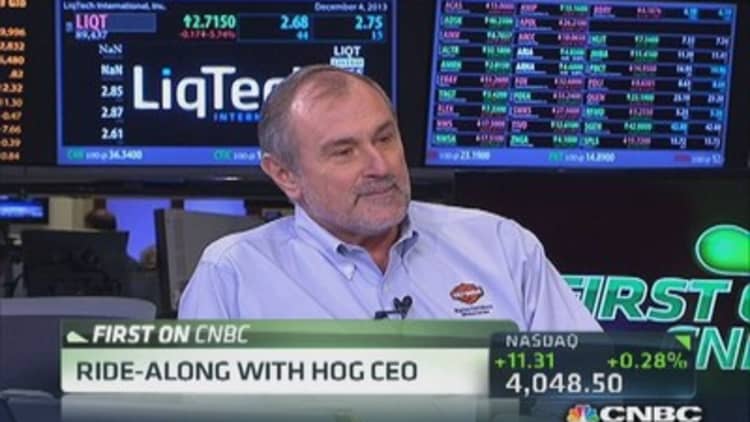Fund managers and traders have chased hog prices on the Chicago Mercantile Exchange to record highs on fear of a deadly pig virus, but a market reversal is likely if government data in the next two weeks shows no major damage from the disease.
At $14 billion, lean hogs are a relatively small part of the U.S. agricultural futures market—about half the size of corn and less than a third of soybeans. But hogs are this year's second-best performing commodity with a 40 percent price gain.
"We've had an 'anticipatory rally' that really needs to be a 'confirming rally' of tightening supplies,'' said John Ginzel, an analyst with Linn Group in Chicago. "We're not seeing a clear enough indication of that yet.''
(Read more: )
Much of the run-up has been spurred by fear about the longer-term damage the Porcine Epidemic Diarrhea virus could do to the nation's pig industry. Nearly a year after it was detected, the PEDv, as it is called, has killed an estimated 6 percent of the hog population. Many continue to fear its impact heading into the summer, when meat demand for barbecuing is at its highest.
"There are a fair amount of questions to be answered in the next 60 to 90 days'' on the risk posed by the virus to hog production, said Steve Wagner, an agricultural markets analyst at CHS Hedging in St. Paul, Minn.
"At some point, this thing is going to blow up.''
Shake-up in 2 weeks?
The first shake-up could arrive with the U.S. Department of Agriculture's quarterly hog report on March 28, which will include the PEDv impact over the past three months and a supply forecast into June.
So far, PEDv has been confirmed on nearly 4,500 farms in 27 U.S. states after first being detected in May 2013.
It is unknown officially how many pigs died from the virus. But some economists estimated losses of at least 4 million hogs.
As of Dec. 1, 2013, the country's hog herd stood at 65.9 million head, according to the USDA.
Market players have thus far relied on hog slaughter data for an indication of meat supply. In the week to March 15, packers harvested 7.7 percent fewer hogs than a year ago and pork output dropped by 5.4 percent, data showed.
(Read more: )
Dan Vaught, economist at Doane Advisory Services in St. Louis, cautions against relying solely on such year-over-year slaughter data. He said a milder winter and relatively high feed costs in March 2013 forced more hogs into the marketplace than this year, when snow storms often delayed transportation.
USDA quarterly data is a better measure, Vaught said.
"Given the latest slaughter numbers, we have to start looking for forthcoming totals to fall well below what USDA projected in the December report,'' he said. The December USDA report, issued before heightened fears over the PEDv, projected only a 1 percent drop in output.

Wary of a sharp meat shortage in the summer, hog processors have bid up prices since the year began and retailers stocked up more than usual, sending lean hogs to record highs of nearly $1.20 a pound, versus last year's close of above 85 cents.
"The cash hog market is advancing so quickly, futures have to rally every day to keep pace,'' said Randall Cleland, a veteran hog trader at Florida-based Tanyard Creek Capital.
"Even at these record price levels, the psychology of the market remains extremely bullish,'' said Cleland, who uses the spreads strategy of simultaneously buying one hog contract and selling another to minimize risk.
"Heck of an opportunity"
Since the end of December, non-commercial investors in CME-traded lean hogs have raised their net long-only positions that bet on price gains by 77 percent to 72,351 contracts.
A year ago, the non-commercial investors, who don't raise pigs or participate in any hog-related industrial activity, were betting on a price drop with a net-short of 7,030 contracts.
While some of these investors had traded livestock, including futures of live cattle, for years, a number who came into this year's hog market were fund managers for institutions such as pensions or family offices that sensed an opportunity from the PEDv crisis.
These fund managers, invested on the CME and exchange-traded products of livestock, could hasten any price reversal in hogs.
(Read more: )
"The market's vertical move is evidence of the fear and greed currently at work,especially seeing that no one knows quite how severe the impact from the virus is,'' said Dan Norcini, who trades hog futures from his Idaho home.
Wagner, the Minnesota-based analyst with CHS, said traders and fund managers expected a 5 to 30 percent drop in hog output between June and August, the peak summer and barbecuing months.
His own estimate was a conservative 10 percent drop.
Funds in the game were eyeing "one heck of an opportunity," he added.
—By Reuters

